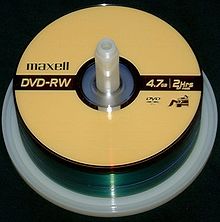- DVD-RW
-
Optical discs Optical media types - Blu-ray Disc (BD): BD-R, BD-RE
- DVD: DVD-R, DVD+R, DVD-R DL, DVD+R DL, DVD-R DS, DVD+R DS, DVD-RW, DVD+RW, DVD-RAM, DVD-D, DVD-A, HVD, EcoDisc
- Compact Disc (CD): Red Book, CD-ROM, CD-R, CD-RW, 5.1 Music Disc, SACD, Photo CD, CD Video (CDV), Video CD (VCD), SVCD, CD+G, CD-Text, CD-ROM XA, CD-i
- Universal Media Disc (UMD)
- Enhanced Versatile Disc (EVD)
- Forward Versatile Disc (FVD)
- Holographic Versatile Disc (HVD)
- China Blue High-definition Disc (CBHD)
- HD DVD: HD DVD-R, HD DVD-RW, HD DVD-RAM
- High definition Versatile Multilayer Disc (HD VMD)
- VCDHD
- GD-ROM
- MiniDisc (MD) (Hi-MD)
- Laserdisc (LD) (LD-ROM)
- Video Single Disc (VSD)
- Ultra Density Optical (UDO)
- Stacked Volumetric Optical Disk (SVOD)
- Five dimensional disc (5D DVD)
- Nintendo optical disc (NOD)
Standards - SFF ATAPI/MMC
- Mount Rainier (packet writing)
- Mount Fuji (layer jump recording)
- Rainbow Books
- File systems
See also A DVD-RW disc is a rewritable optical disc with equal storage capacity to a DVD-R, typically 4.7 GB. The format was developed by Pioneer in November 1999 and has been approved by the DVD Forum. The smaller Mini DVD-RW holds 1.46 GB, with a diameter of 8 cm.
The primary advantage of DVD-RW over DVD-R is the ability to erase and rewrite to a DVD-RW disc. According to Pioneer, DVD-RW discs may be written to about 1,000 times before needing replacement. DVD-RW discs are commonly used to store data in a non-volatile format, such as when creating backups or collections of files. They are also increasingly used for home DVD video recorders. One benefit to using a rewritable disc is if there are writing errors when recording data, the disc is not ruined and can still store data by erasing the faulty data.
One competing rewritable format is DVD+RW. Hybrid drives that can handle both, often labeled "DVD±RW", are very popular due to the lack of a single standard for recordable DVDs.
The recording layer in DVD-RW and DVD+RW is not an organic dye, but a special phase change metal alloy, often GeSbTe. The alloy can be switched back and forth between a crystalline phase and an amorphous phase, changing the reflectivity, depending on the power of the laser beam. Data can thus be written, erased and re-written.
Contents
Drive Specifications
Standard DVD-R/RW compatible drives use a 650nm red semiconductor laser diode. The average power consumption rating is 250mW to 400mW. Power consumption varies depending on the write speeds and dual layer support. Higher speed drives require more power for increased data throughput, and dual layer disks require more power to penetrate to the second layer of data.
Dual layer
A specification for dual-layer DVD-RW discs with a capacity of 8.5 GB was approved by the DVD Forum.[1] However, manufacturing support for rewritable dual-layer discs did not materialize due to costs and expected competition from newer and higher-capacity formats like Blu-ray and HD DVD.
References
- ^ DVD Specifications for Re-recordable Disc for Dual Layer (DVD-RW for DL) Physical Specifications, Version 2.0
External links
- ISO/IEC 17342, 80 mm (1,46 Gbytes per side) and 120 mm (4,70 Gbytes per side) DVD re-recordable disk (DVD-RW)
- ISO/IEC 17342:2004 - publicly available standard
- Understanding Recordable & Rewritable DVD by Hugh Bennett
- DVD Forum

This computer storage-related article is a stub. You can help Wikipedia by expanding it.

